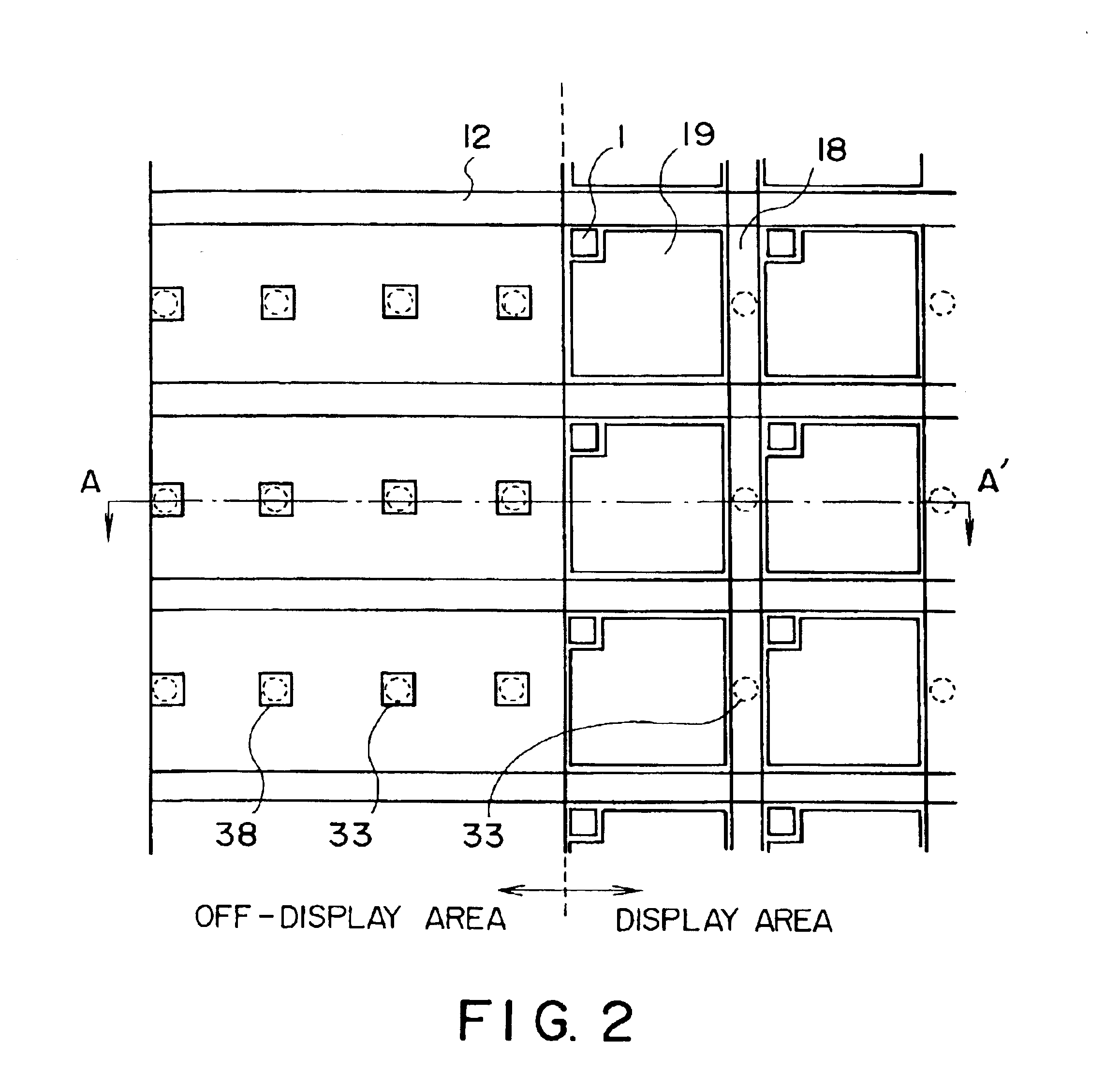Liquid crystal display device
a liquid crystal display and display device technology, applied in non-linear optics, instruments, optics, etc., can solve the problems of reducing the yield of products, difficult to uniformly disperse spacers, and reducing contrast, so as to increase the mechanical strength of spacers, and reduce the number of steps
- Summary
- Abstract
- Description
- Claims
- Application Information
AI Technical Summary
Benefits of technology
Problems solved by technology
Method used
Image
Examples
first embodiment
[0064]FIG. 1 is a sectional view illustrating a liquid crystal display device in accordance with the present invention. This sectional view shows a section cut substantially along the line A-A′ in a plan view illustrating an array pattern of FIG. 2. Pixel electrodes 19 corresponding to pixels are arrayed in matrix on a display area. Further, a thin-film transistor (TFT: Thin Film Transistor) 1 serving as a switching element is provided per pixel.
[0065]This liquid display device is structured such that an active matrix substrate 10 defined as a lower substrate and an opposite substrate 30 defined as an upper substrate are disposed in parallel with a liquid crystal 40 interposed therebetween, and the liquid crystal 40 is sealed by a sealing material 37.
[0066]At first, the active matrix substrate 10 is constructed such that a TFT 1 is provided on a glass substrate 11, and the pixel electrode 19 is connected to the TFT 1.
[0067]FIG. 3 is a sectional view of the active matrix substrate. A...
second embodiment
[0090]In accordance with the second embodiment, it is feasible to prevent an occurrence of vacuum bubbles in the vicinity of the display area, which are easy to produce due the enhancement in terms of the density of the number of pillar-shaped spacers 33 and to reduce the cell gap defect.
[0091]A third embodiment will be explained with reference to FIG. 6. In the third embodiment also, the basic structure of the device is the same as that in the first embodiment. However, a volume of the pillar-shaped spacer 33 changed depending on the display area and the off-display area. That is, in the case of the liquid crystal device, the two substrates are disposed substantially in parallel, and an inter-substrate distance is fixed. Therefore, changing the volume of the pillar-shaped spacer has substantially the same meaning as changing the thickness of the pillar-shaped spacer. This can not, however, apply in such a case that the pillar-shaped spacer takes a tapered shape and has the thicknes...
third embodiment
[0092] a diameter of the red color layer 33R partly constituting the pillar-shaped spacer 33 is set to about 10 μm, a diameter of the green color layer 33G is set to about 13 μm, and a diameter of the blue color layer 33B is set to about 16 μm, thus setting the thickness of the pillar-shaped spacer 33 in the display area. The diameter of 33R is about 20 μm, the diameter of 33G is about 26 μm, and the diameter of 33B is about 32 μm, thus setting the thickness thereof in the off-display area.
[0093]A fourth embodiment will be described with reference to FIG. 7. In the fourth embodiment, the off-display area is divided into two subareas, i.e., a subarea (D3) close to the display area and a subarea (D4) far from the display area. The diameter of 33R partly constituting the pillar-shaped spacer 33 is set to about 10 μm, the diameter of 33G is set to about 13 μm, and the diameter of 33B is set to about 16 μm, thus setting the thickness of the pillar-shaped spacer 33 in the display area. Th...
PUM
 Login to View More
Login to View More Abstract
Description
Claims
Application Information
 Login to View More
Login to View More - R&D
- Intellectual Property
- Life Sciences
- Materials
- Tech Scout
- Unparalleled Data Quality
- Higher Quality Content
- 60% Fewer Hallucinations
Browse by: Latest US Patents, China's latest patents, Technical Efficacy Thesaurus, Application Domain, Technology Topic, Popular Technical Reports.
© 2025 PatSnap. All rights reserved.Legal|Privacy policy|Modern Slavery Act Transparency Statement|Sitemap|About US| Contact US: help@patsnap.com



